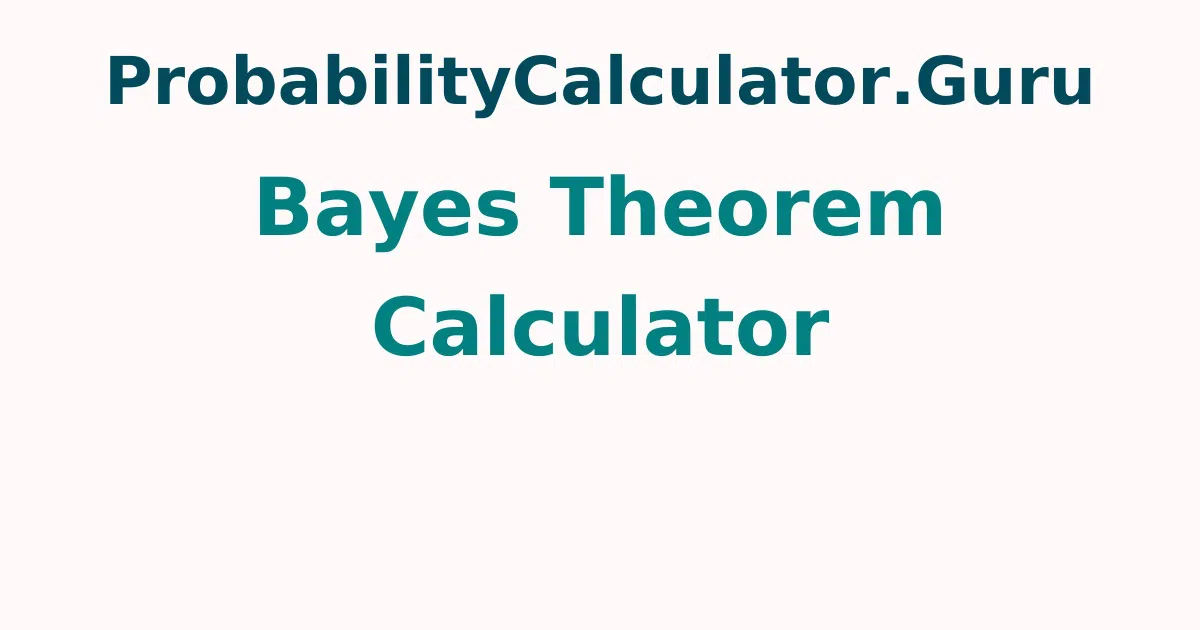Bayes Theorem Calculator Or Bayes Rule Calculator
Created By : Vaibhavi Kumari
Reviewed By : Phani Ponnapalli
Last Updated : Mar 18, 2023
Bayes Theorem Calculator Or posterior probability calculator is a simple tool used for finding the probability of an event using the Baye's Theorem. This online tool will provide the conditional probability of an event provided the related known probabilities. All you need to do is simple enter the input data values in the allotted input provisons and then click on the calculate button highlighted in the tool to obtain the conditional probability of an event.
What is Baye's Theorem?
Bayes Theorem is given after the name of Reverend Thomas Bayes who worked on conditional probability. Baye's Rule determines the posterior probability of an event considering all other related events prior probabilities. Importance of Baye's Law in statistics is that it can be compared to importance of Pythagorean Theorem in Math.
Baye's Theorem Formula
In simple terms we are determining the conditional probability of events i.e. P(A|B) - nothing but the likelihood of event A occuring if B is true. We can denote the Baye's Rule using the following formula P(A|B) = [P(B|A) * P(A)] / P(B)
- where: A and B are certain events.
- P(A) is the probability of event A occurring.
- P(B) is the probability of event B occurring.
- P(A|B) is the conditional probability of event A occurring when B has happened.
- Similarly P(B|A) is the conditional probability of event B occurring when A has happened.
Similarly we can reverse the above equation to obtain the likelihood of event B given that A has happened P(B|A) = [P(A|B) * P(B)] / P(A)
Understand the difficult concepts too easily taking the help of the online tools available at Probabilitycalculator.guru and clarify your doubts during homework or assignments.
Baye's Law Formula Tests
We can extend Bayes Theorem to two or more cases of Event A. This can be used to test false positives or false negatives. Event B's Probability is defined as P(B) = P(A) * P(B|A) + P(not A) * P(B|not A) in which P(not A) is the probability of the event A not occurring. This equation holds true P(not A) + P(A) = 1 as event A may or may not occur.
Baye's Rule Formula can be extended using the equation P(A|B) = [P(B|A) * P(A)] / [P(A) * P(B|A) + P(not A)* P(B|not A)]
Bayes Theorem can help us determine the chances when a test is wrong. Have you ever thought of what is the likelihood of someone having an energy. False positive is something when results show a person not having an allergy. On the other hand, false negative is something when a person having an allergy is not shown. In this case, we can use the Baye's Formula to determine the probabilities of such cases happening around.
How to use the Bayes Law Calculator?
Go through the simple procedure listed below to know the functionality of Bayes Theorem Calculator and they are as beneath
- Firstly, enter the probabilities in the input fields allotted.
- Now, tap on the calculate button to obtain the unknown value as result.
- The conditional probability of an event using baye's formula will be displayed on the new window.
Bayes Theorem Applications
Bayes Theorem is applicable to many streams and subjects such as philosophy, sports, pharmaceuticals, science and engineering, etc.
- You can determine the probability of a person having disease or not using bayesian inference given medical history and other data. One of the common example in medicine is Cancer Screening.
- Bayesian Inference plays a prominant role in statistical inferences.
- In Banking and Finance Sector, we can use the Bayes Rule to find out the risk of lending money to potential customers who can have chances of not repaying them.
- Insurance Companies use this to estimate the risk and calculate insurance premiums accordingly.
- It is also used in genetics, taking decisions about monetary policies, global warming risk as well.
- Enigma code during the world war II was decoded using this Bayes Theorem Approach.
FAQs on Bayes Theorem Calculator
1. What is Bayes Theorem in Simple Terms?
Bayes Theorem is a mathematical equation used in statistics and probability to find out the conditional probability of an event.
2. What is Bayes Theorem explain its application with an example?
Bayes Theorem is used for determining the Conditional Probability. Its applications in real life include cancer screening, taking decisions in monetary policies, global warming, etc.
3. What is the Bayes Theorem Formula Or bayes theorem equation?
Bayes Theorem Formula is given by the equation P(A|B) = [P(B|A) * P(A)] / P(B). You can use bayes formula calculator.
4. Where do I get Bayes Theorem Calculator or bayes' theorem calculator for free?
You can get Bayes Theorem Calculator for free on probabilitycalculator.guru a trusted and reliable portal.
